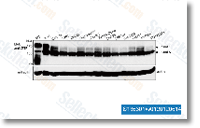Solutions Clinical specimens All University of California, San Diego and University of California, Irvine individuals were consented in accordance with all the protocols accepted by their respective Institutional Evaluation Board of the university. Snap frozen tissue samples had been subjected to mechanical pulverization, followed by disrup tion from the tissue in lysis buffer and DNA/RNA extraction using AllPrep DNA extraction kits according for the manufacturers recommenda tion. Germline DNA was extracted from blood clots utilizing Qiagen Clotspin Baskets and DNA QIAmp DNA Blood maxi kits and from saliva samples in accordance to your respective manufac turers protocol. Data generation The information have been produced in accordance to our published UDT Seq approach. Briefly, the genomic DNA samples have been fragmented to an average size of 3 kb.
To prepare the input DNA template mixture for targeted amplification, 1. 5 ug from the purified genomic DNA fragmentation reac tion was extra to 9. 4 ul of ten? Substantial Fidelity Buffer two. five ul of 50 mM MgSO4, 2. 5 ul of ten mM dNTP, seven. two ul of 4 M Beta ine, seven. two ul RDT Droplet Stabilizer, three. 6 ul dimethyl sulfoxide and one. four ul of 5 units/ul Platinum Substantial Fidelity Taq, and selleckchem the samples had been brought to a last volume of 50 ul with nuclease free of charge water. The primer droplets had been merged with all the sample droplets around the RDT1000. The PCR reactions were carried out as follows, initial denaturation at 94 C for two minutes, 55 cycles at 94 C for 30 seconds, 54 C for 30 seconds and 68 C for 60 seconds, and last extension at 68 C for 10 minutes, followed by a 4 C hold.
Immediately after breaking the emulsion and purification buy BGB324 in the amplicons, the samples have been subjected on the sec ondary PCR employing 0. 5 uM ultimate concentration of the uni versal forward primer and an index certain reverse primer. Samples had been amplified as follows, original denaturation at 94 C for 2 mi nutes, 10 cycles at 94 C for 30 seconds, 56 C for thirty sec onds and 68 C for one minute, and ultimate extension at 68 C for 10 minutes, followed by a 4 C hold. The purified amp lified library was then analyzed on an Agilent Bioanalyzer to quantify final amplicon yield and pooled in equimolar amounts. The pool was loaded at between 8 and eleven pM and sequenced about the Illumina MiSeq sequencing instrument for 2 ? 150 cycles making use of customized sequencing primers. The resulting reads had been deconvoluted based on their index sequence. The  raw reads are publi cally obtainable as a result of the Short Reads Archive at the NCBI, SRA067610 and SRA067611. The libraries were se quenced to an typical of three. one million 151 bp long paired end reads per sample. Data analysis Mutascope The examination was performed employing Mutascope capable of de tecting mutations at 1% allelic fraction with substantial sensitivity. We initial identified probable false constructive variants.
raw reads are publi cally obtainable as a result of the Short Reads Archive at the NCBI, SRA067610 and SRA067611. The libraries were se quenced to an typical of three. one million 151 bp long paired end reads per sample. Data analysis Mutascope The examination was performed employing Mutascope capable of de tecting mutations at 1% allelic fraction with substantial sensitivity. We initial identified probable false constructive variants.
Anhydrase Signal
Renal carbonic anhydrase allows the reabsorption of bicarbonate ions in the proximal tubule.
